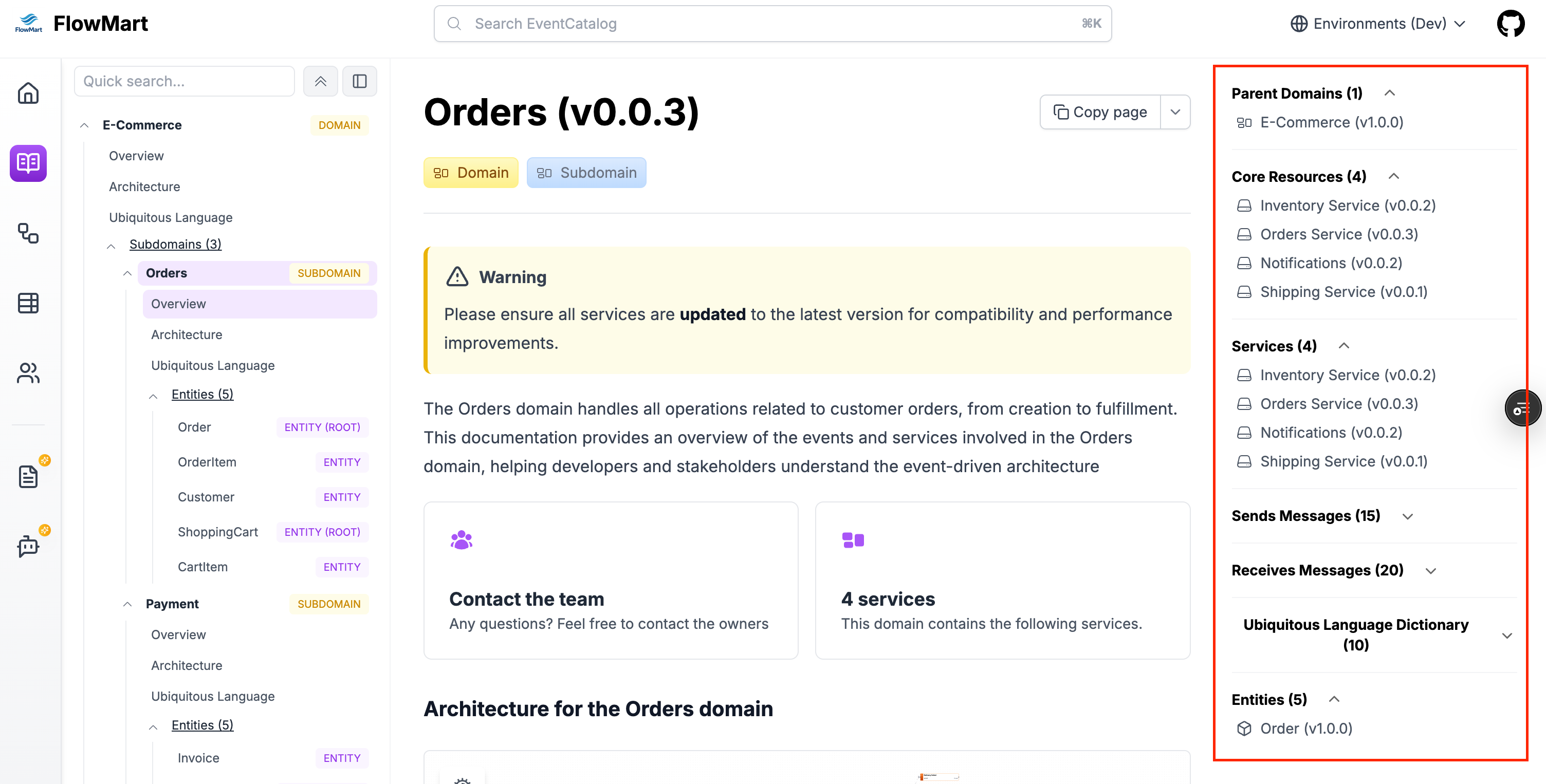Domain frontmatter API
Overview
Domains are just markdown files, with this comes the use of Content, MDX components and also front-matter.
Here is an example of the domain frontmatter you will find in your domain files.
---
# id of your domain, used for slugs and references in EventCatalog.
id: Orders
# Display name of the domain, rendered in EventCatalog
name: Orders
# Version of the domain
version: 0.0.1
# Short summary of your domain
summary: |
Domain that contains order related information
# Optional owners, references teams or users
owners:
- dboyne
# Optional services. Groups services into this domain.
services:
- id: PaymentService
version: 0.0.1
# Optional badges, rendered to UI by EventCatalog
badges:
- content: New domain
backgroundColor: blue
textColor: blue
# Optional icon to display (from https://heroicons.com/)
# Or the name of the broker (e.g Kafka, EventBridge, etc)
icon: BoltIcon
---
## Overview
Domain that contains all services that are related to the orders domain within FakeCompany.
<NodeGraph />
Required fields
id
- Type:
string
Unqiue id of the domain. EventCatalog uses this for references and slugs.
---
id: Orders
---
name
- Type:
string
Name of the domain this is used to display the name on the UI.
---
name: My orders domain
---
version
- Type:
string
Version of the domain.
---
version: 0.0.1
---
Optional fields
summary
Short summary of your domain, shown on domain summary pages.
---
summary: |
Domain that contains everything about orders
---
owners
An array of user ids that own the domain.
---
owners:
- dboyne
- mSmith
---
services
An array of services ids that belong to the this domain. Which services belong to this domains bounded context.
---
services:
- id: InventoryService
- id: OrderService
# Optional version of the service, latest version is used if not provided
version: 0.0.1
---
entities
eventcatalog@2.36.0An array of entities ids that belong to the this domain. Which entities belong to this domains bounded context.
---
entities:
- id: Order
- id: OrderItem
# Optional version of the entity, latest version is used if not provided
version: 0.0.1
---
badges
An array of badges that get rendered on the page.
---
badges:
- content: My badge
backgroundColor: blue
textColor: blue
# Optional icon to display (from https://heroicons.com/)
# Or the name of the broker (e.g Kafka, EventBridge, etc)
icon: BoltIcon
---
specifications
eventcatalog@2.6.0Specifications to include on the page
eventcatalog@2.39.1You can assign one or more specifications to a domain.
---
specifications:
- type: asyncapi
path: order-service-asyncapi.yaml
name: AsyncAPI Specification
- type: openapi
path: openapi.yml
name: OpenAPI Specification
- type: graphql
path: graphql.yml
name: GraphQL Specification
---
| Property | Type | Required | Description |
|---|---|---|---|
type | string | Yes | The type of specification, currently only asyncapi and openapi are supported |
path | string | Yes | The path to the specification file |
name | string | No | Optional friendly name of the specification, rendered in the UI |
Older versions of EventCatalog (< 2.39.0)
If you are using an older version of EventCatalog you will need to use the following syntax.
---
specifications:
asyncapiPath: order-service-asyncapi.yaml
openapiPath: openapi.yml
---
visualiser
eventcatalog@2.39.2Turn off the visualiser for this resource. This means the resource will not be included in the visualiser or the navigation bar for the visualiser.
Default: true
---
visualiser: false
---
editUrl
eventcatalog@2.49.4Override the default edit url for the page. This is used to navigate the user to the edit page for the page (e.g GitHub, GitLab url).
---
editUrl: https://github.com/event-catalog/eventcatalog/edit/main/domains/Orders/index.mdx
---
detailsPanel
eventcatalog@2.53.0Override the default details panel for the page. You can use this show/hide areas of the details panel.

---
detailsPanel:
services:
visible: false
entities:
visible: true
messages:
visible: false
ubiquitousLanguage:
visible: false
---
Options:
| Property | Type | Required | Description |
|---|---|---|---|
services | object | No | An object with a visible property to show/hide the services section |
entities | object | No | An object with a visible property to show/hide the entities section |
messages | object | No | An object with a visible property to show/hide the messages section (sends and receives) |
ubiquitousLanguage | object | No | An object with a visible property to show/hide the ubiquitous language section |
repository | object | No | An object with a visible property to show/hide the repository section (e.g GitHub, GitLab url) |
versions | object | No | An object with a visible property to show/hide the versions section |
owners | object | No | An object with a visible property to show/hide the owners section |
changelog | object | No | An object with a visible property to show/hide the changelog button |
attachments
eventcatalog@2.57.2An array of attachments for this resource type.
---
attachments:
- url: https://example.com/adr/001
title: ADR-001 - Use Kafka for asynchronous messaging
description: Learn more about why we chose Kafka for asynchronous messaging in this architecture decision record.
type: 'architecture-decisions'
icon: FileTextIcon
- https://example.com/adr/002
---
Options:
The attachments can be a url (string) or an object with additional properties.
Object properties:
| Property | Type | Required | Description |
|---|---|---|---|
url | string | Yes | The url of the attachment |
title | string | optional | The title of the attachment |
description | string | optional | The description of the attachment |
type | string | optional | The type of the attachment, this will be used to group attachments together in the UI |
icon | string | optional | The icon of the attachment, you can pick from the lucide icons library. |